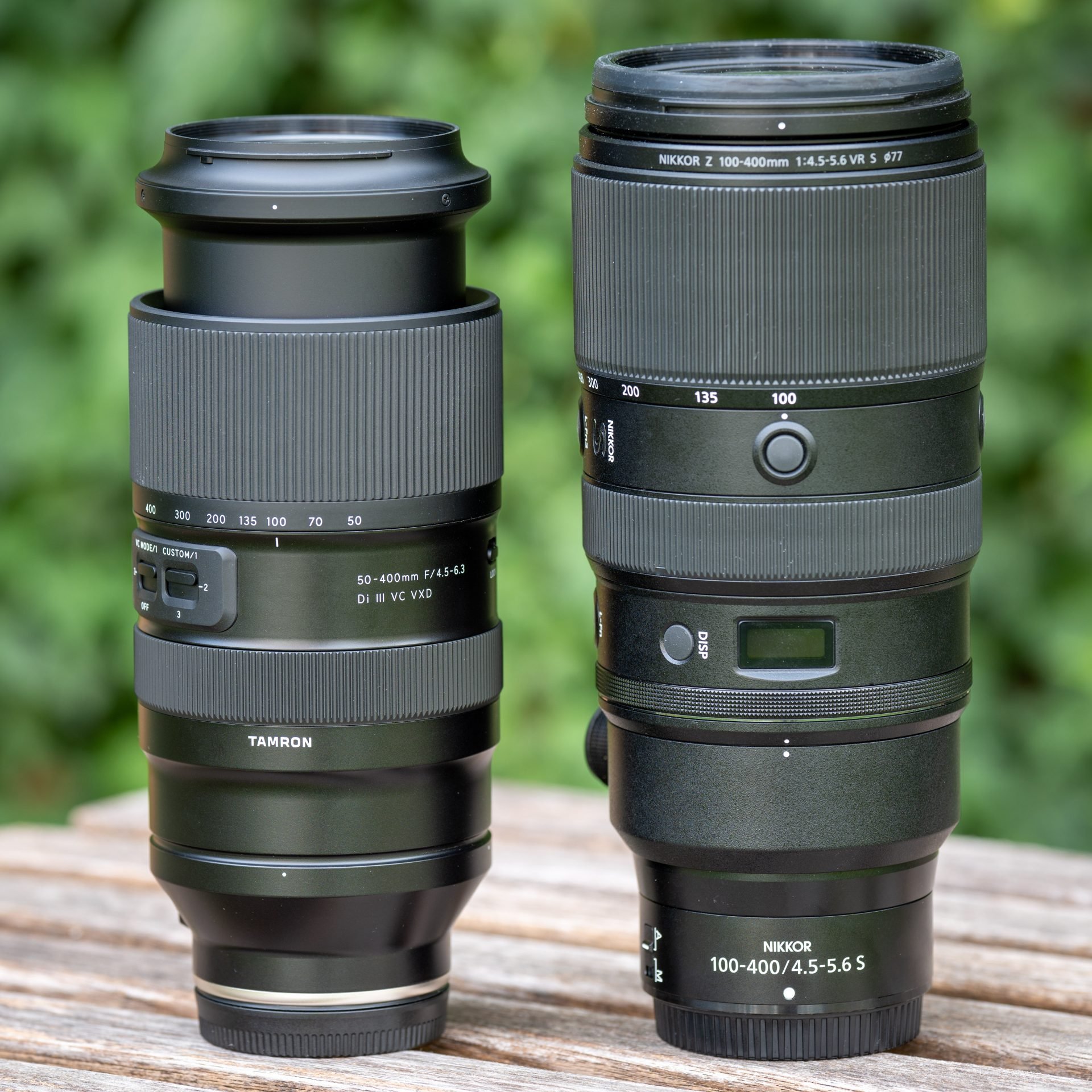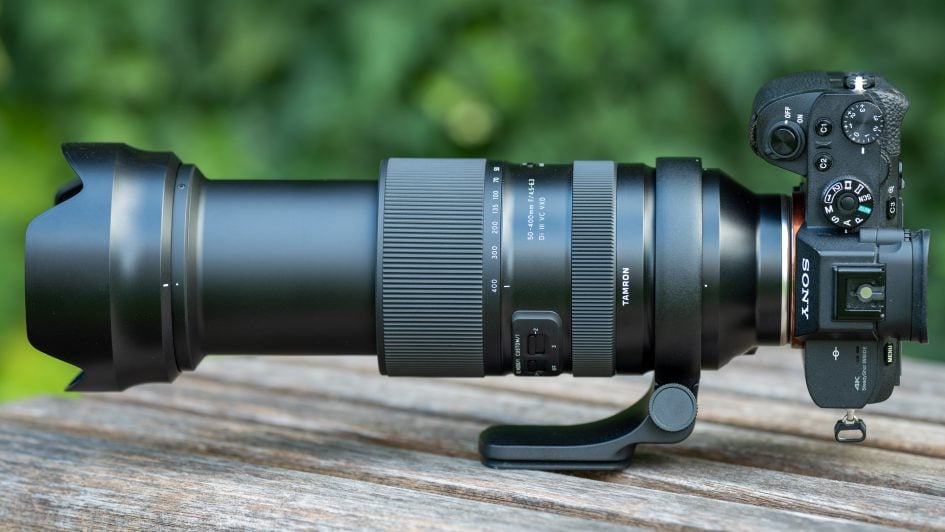Tamron 50-400mm f4.5-6.3 Di III VC review
-
-
Written by Thomas
Intro
The Tamron 50-400mm f4.5-6.3 Di III VC VXD (model A067) is a 8x zoom lens designed for Sony’s Alpha mirrorless cameras and corrected for full-frame sensors. Announced in July 2022, it complements Tamron’s other telephoto zoom lenses for those who need more flexibility: It covers a huge zoom-range from a “standard” 50mm angle-of-view up to a long telephoto reach of 400mm.
Unlike its shorter siblings Tamron’s new 50-400mm zoom lens features optical image stabilization (VC) – an essential feature for long telephoto lenses. It also is fully weather-sealed including fluorine coating on the front lens and Tamron offers a removable tripod-collar with Arca-Swiss style tripod interface as optional accessory. The lens is pretty lightweight at 1155g (without tripod-collar or lens hood) and only 183mm long (without lens hood) but – like many other long telephoto designs – extends when zoomed in. Tamron has equipped the lens with a zoom lock, but missed out on the “flex zoom lock” of their 150-500mm f5-6.7 Di III VC. And for those who like to capture small objects the 50-400mm f4.5-6.3 Di III VC allows for a maximum magnification of 1:2 at the wide end and 1:4 at the long end with a good working distance.
The lens is made in Vietnam and is priced at 1449 EUR / 1299 USD / 1249 GBP. So far, it’s only available for Sony E-mount. PS – if you’re interested in Tamron’s other full-frame telephoto zoom lenses for E-mount I’ve tested so far check out my in-depth reviews of the Tamron 35-150mm f2-2.8 Di III, Tamron 70-180mm f2.8 Di III VXD, and Tamron 150-500mm f5-6.7 Di III VC.
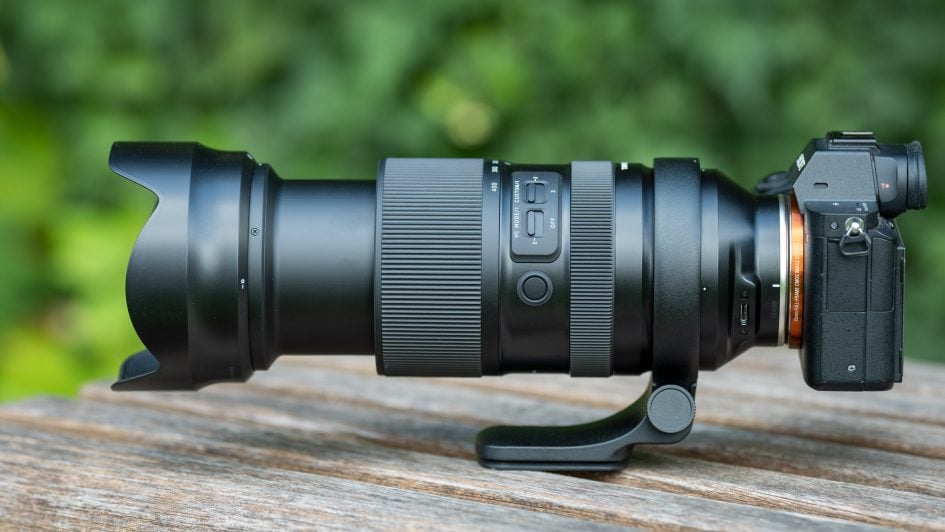
Facts and features
Let’s compare the new Tamron 50-400mm f4.5-6.3 Di III VC (“Tamron 50-400” for short) to the Sigma 100-400mm f5-6.3 DG DN OS (“Sigma 100-400”), Sony FE 100-400mm f4.5-5.6 GM OSS (“Sony 100-400”), and Tamron 150-500mm f5-6.7 Di III VC (“Tamron 150-500”). As usual I’ve rated the features with a [+] (or [++]), when it’s better than average or even state of the art, a [0] if it’s standard or just average, and [-] if there’s a disadvantage.
Size (diameter x length): 89 x 183mm (3.5 x 7.2in.) plus 46mm for the lens hood. The Sigma 100-400 is 86 x 199mm, the Sony 100-400 is 94 x 205mm (both without lens hood), and the Tamron 150-500 is 93 x 209mm + 55mm lens hood. All four lenses in this comparison extend when zoomed to their longest focal length: The Tamron 50-400 extends to 259mm, the Tamron 150-500 to 283mm (without lens hood). [+]
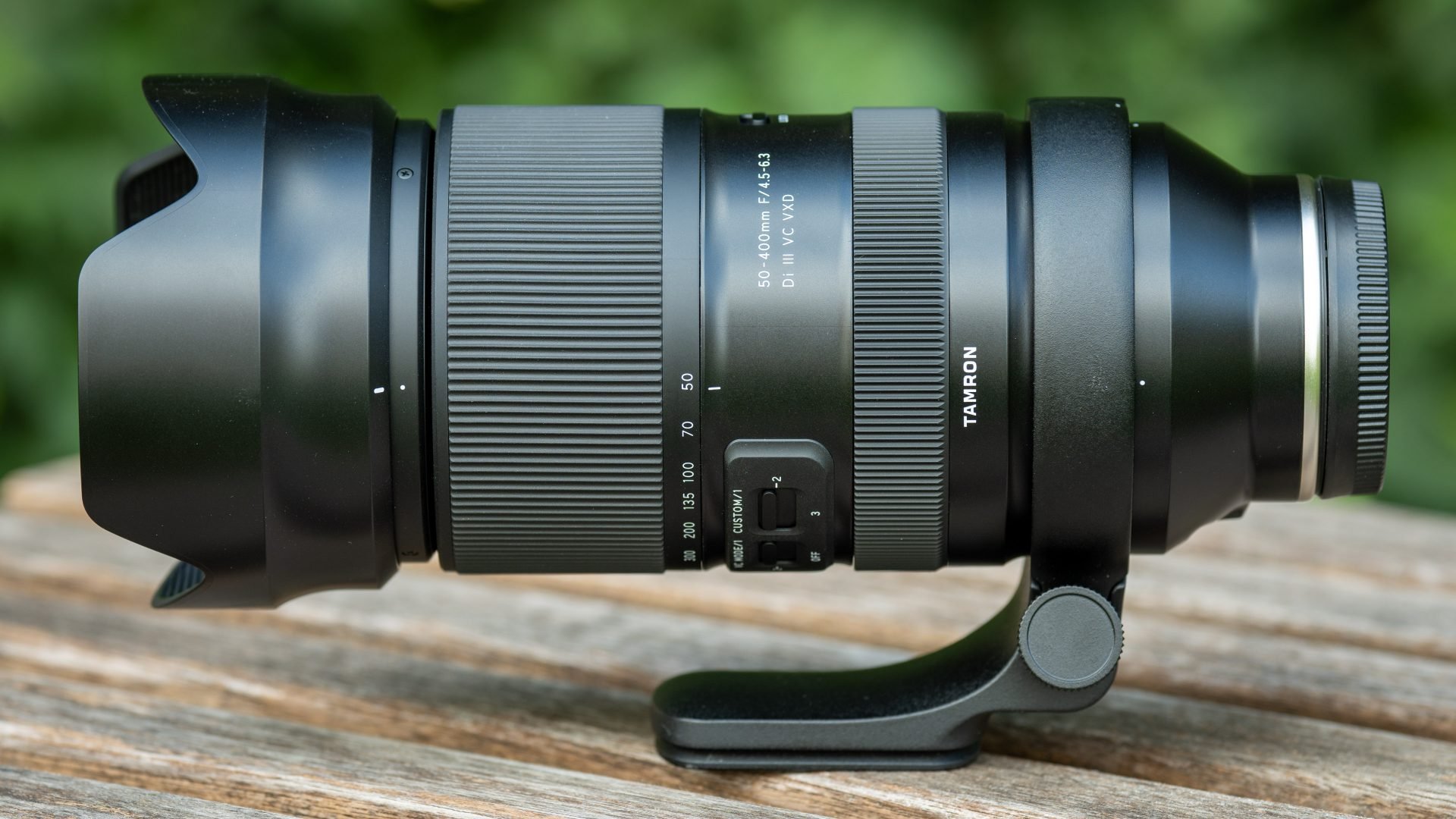
Weight: At 1155g (2.5 lb.) plus 54g for the lens hood the Tamron 50-400 is much lighter than the Tamron 150-500 at 1725g + 95g lens hood. The optional tripod collar adds another 146g. The Sigma 100-400 is the lightest by a small margin at 1140g, the Sony 100-400 is 1395g (without tripod collar or lens hood). [+]
Optics: The Tamron 50-400mm f4.5-6.3 Di III VC is a pretty complex design with 24 elements in 18 groups including 5 special dispersion elements and 2 aspherical elements. The other lenses in this comparison are of a similarly complex construction. Both Tamrons and the Sony have fluorine coating at the front lens to repel water, dust, and dirt and make cleaning easier. [+]
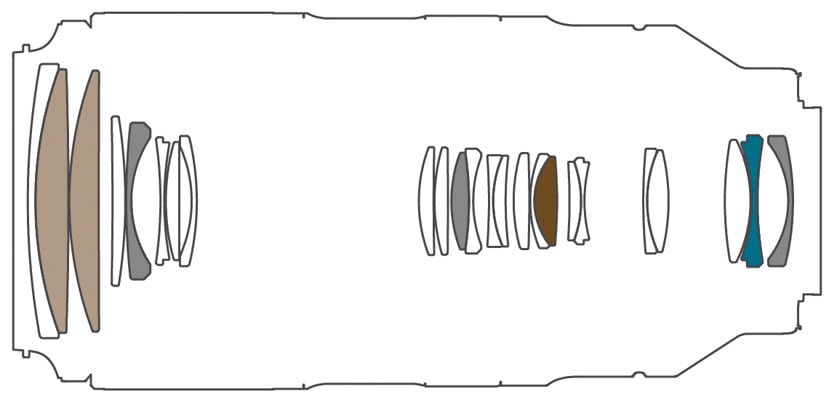
Minimum object distance is 0.25m (0.8ft.) with a magnification of 1:2 and a working distance of 5cm (2in.) at 50mm focal length. At 400mm focal length maximum magnification is 1:4 (or 1:3.8 in manual focus) which is still quite good and results in a much longer working distance of around 1.2m (3.9ft.) even with the lens hood attached. For details see table below. The Tamron 150-500 achieves 1:3.1 at 150mm focal length and 1:3.7 at 500mm. The Sigma and Sony achieve their maximum magnification at their longest focal length: This is 1:4.1 at 1.3m working distance for the Sigma 100-400 and 1:2.9 at 0.7m working distance for the Sony 100-400. The Tamron 50-400 achieves a magnification of 1:10 at 3.92m object distance (and 400mm focal length). [+]

Focal ratio: All lenses in this comparison have a focal ratio which becomes smaller the further you zoom in. The Tamron 50-400 starts at f4.5 at 50mm focal length and reduces its focal ratio to f5.0 from 61mm, f5.6 from 87mm and f6.3 from 158mm onwards. The Sigma 100-400 offers its maximum f5 between 100 and 113mm, closing to f5.6 between 113 and 235mm, after which it’s f6.3 between 235 and 400mm. Sony’s maximum f4.5 is available between 100 and 116mm, before closing to f5 between 116 and 164mm, then reducing to f5.6 between 164 and 400mm. The Tamron 150-500 starts at f5.0 at the short end closing to f5.6 at 250mm, f6.3 at 400mm, f6.7 at 500mm. So, the Tamron 50-400 is 1/3 to 2/3 of a stop slower than the other lenses in this comparison. [-]
Use with teleconverters: No, neither the Tamrons nor the Sigma can be used with Sony’s teleconverters. [0]
Filter-thread: 67mm which a lot of other Tamron zoom lenses (and the Sigma 100-400) use. The Sony 100-400 has a 77mm thread, the Tamron 150-500 needs even larger 82mm filters. [+]
Image stabilization: All lenses in this comparison have optical image stabilization built in. This works together with the sensor-based image stabilization of the Sony Alpha mirrorless cameras. The Tamron 50-400 has a switch to activate two VC modes or turn stabilization off. [+]
Autofocus: All lenses in this comparison offer autofocus with built-in focus drive. Manual-focus override is by simply turning the dedicated focus ring. The action of the focus ring on the Tamron 50-400 can be switched via Tamron’s lens Utility (TLU) between the usual variable gearing or linear gearing (with four different choices of rotation angles from 90 degrees to 360 degrees) and the direction of the ring can be reversed. The other lenses do not offer such a functionality. [+]
All lenses in this comparison cover full frame sensors or can equally be used on a cropped APS-C camera body. [+]
Price: The Tamron 50-400 comes at a recommended retail price of 1449 EUR (incl. 19% VAT) / 1299 USD / 1249 GBP. The tripod mount A035TM is sold separately for 110 EUR / 129 USD but there is at least one third party collar (Haoge LMR-TL140) for 60 EUR / 50 GBP. The Sigma 100-400 currently sells much lower for 990 EUR / 899 USD / 900 GBP, the Sony 100-400 is 2350 EUR / 2500 USD / 2150 GBP, the Tamron 150-500 is 1200 EUR / 1399 USD / 1100 GBP. [0]
Similar to the Sigma 100-400 the Tamron 50-400 comes without a pouch and the Arca-Swiss compatible tripod mount is an optional extra and does not have strap attachment holes like the (included) tripod mount of the Tamron 150-500. The reversible lens hood is included but does not feature a rubberized front end or a lock. The Sony 100-400 comes with a pouch and has the detachable tripod foot included. Its lens hood has a sliding window through which a polarizing or variable ND filter can be adjusted and also has a lock to prevent it from accidentally falling off. [0]
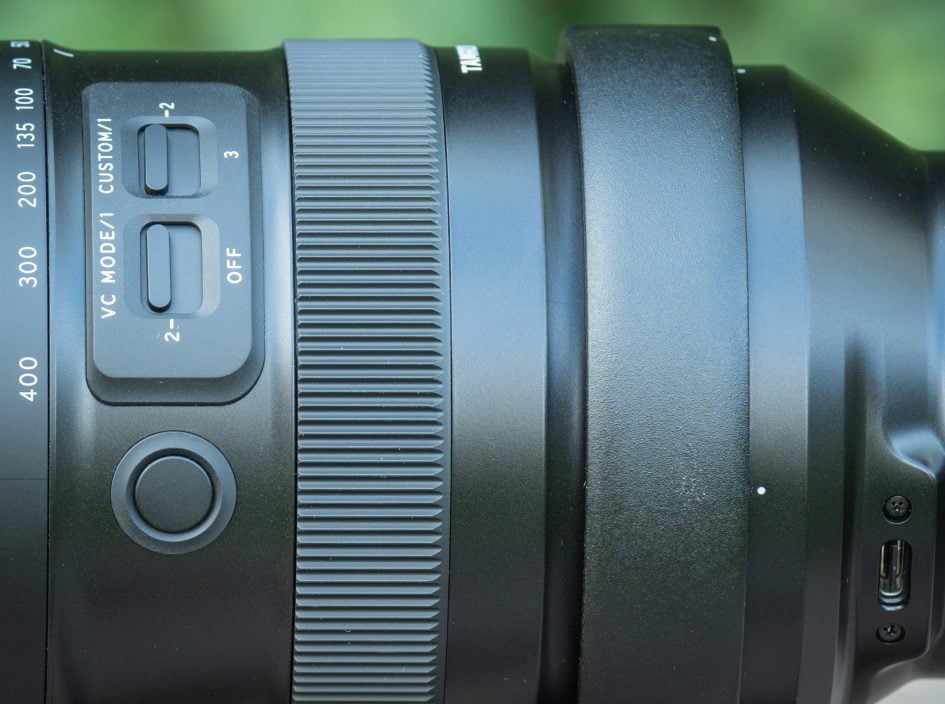
Aperture ring and other control elements: None of the lenses in this comparison has a designated aperture ring. But with Tamron’s Lens Utility (TLU) you can connect a computer to the lens and assign the focus set button to switch the focus ring to operate the aperture. For connecting computer and lens only a USB-C cable is required – no need to buy the TAP-in Console/USB docking station which older Tamron DSLR lenses needed. You can assign other functions to the focus set button apart from the usual focus preset e. g. make the focus automatically shift between two focus positions A and B or assign a function from the camera body. The additional custom switch allows for three different settings for the focus set buttons and focus ring and you can also define a function to limit closest focus to 5/7/10m. The Tamron 150-500 has a direct focus limiter switch instead of the custom switch of the Tamron 50-400 and it offers a nice “Flex Zoom Lock” feature in addition to a standard zoom lock at 150mm: simply push the zoom ring forward to lock the zoom at any position. [+]
Sealing: All lenses in this comparison have a rubber grommet at the lens-mount. Plus further weather-sealing throughout the construction except for the Sigma 100-400. [+]
At a score of 1[-]/3[0]/10[+] the Tamron 50-400mm f4.5-6.3 Di III VC looks like a well featured design. Its only downsides being the meagre focal ratio of f6.3 once you zoom in beyond 150mm and the price which seems a bit on the high side especially considering the tripod mount is not included. But the Tamron 50-400 has a huge 8x zoom-range, is relatively small and light for a lens reaching 400mm focal length, and it has a full range of customizable functions. The lens is thoroughly sealed against the elements and its tripod mount has an Arca-Swiss style interface – I only wish it were included. Plus it can reach magnifications of 1:4 at very usable working distances or 1:2 if you get real close.
Above: Tamron 50-400mm f4.5-6.3 Di III VC (left), Nikon Z 100-400mm f4.5-5.6 VR S (right)
Coverage
With its 8x zoom-range the Tamron 50-400 covers a much larger range than the 3.3x of the Tamron 150-500 or the 4.3x range of a 70-300mm lens. At the short end the Tamron 50-400mm has an angle of view of 47 degrees, compared to the 24 degrees of zooms starting at 100mm and the 16.4 degrees of the Tamron 150-500mm.
Here is the angle of view of the different options (Auto distortion control activated):
Above: Tamron 50-400mm f4.5-6.3 Di III VC coverage on a full-frame camera at 50mm (left) and 400mm (right)
Above: 70-300mm coverage on a full-frame camera (simulated with Tamron 50-400mm f4.5-6.3 Di III VC)
Above: 100-400mm coverage on a full-frame camera (simulated with Tamron 50-400mm f4.5-6.3 Di III VC)
The differences of starting at 50mm, 70mm, or 100mm are quite obvious and could be the decisive factor for choosing a long telephoto zoom lens. The difference at the long end between a lens reaching 300mm or 400mm focal length might not be so impressive. But if you have to crop an image shot at 300mm to match the angle of view from a 400mm shot you’ll be losing 44% of the image area. In other words: if your original image had 42MP you’ll end up at 24MP. This might well be enough for the intended purpose, but it demonstrates nicely the benefits of reaching 400mm at the long end.
Focus and zoom
Focus accuracy and repeatability is critical to consistently produce sharp shots. Repeatability (the accuracy of focus on the same subject after repeated focus-acquisition) of the Tamron 50-400mm f4.5-6.3 Di III VC is good (measured 97.2% in Reikan FoCal) with no outliers over a series of 40 shots. The lens focuses in around 0.6 sec from infinity at 200mm focal length to 2.05m (1:10 magnification), which is quite fast.
The zoom ring has a pretty short throw of 80 degrees and has a 39mm wide rubber surface with a good grip. It turns with quite some resistance and cannot be operated with one finger. Still the lens shows zoom creep so it’s good that it has a zoom lock (at 50mm). The focus ring is 17mm wide and is located closer to the camera. It also has a rubberized surface, moves smoothly, and can easily be operated even with your pinky.
AF-operation of the lens is quiet, be it in photo-mode or if you record video with the built-in microphone. Image stabilization can be heard as a very faint hum from the outside but is not picked up by the built-in microphone.
As you pull focus, you’ll notice very little focus breathing: the image became 1% more magnified when I adjusted focus from infinity to 2.05m at 200mm focal length. This is hardly noticeable when shooting videos. Same at 50mm focal length.
I also tested whether Tamron’s zoom lens allows you to change the focal length without altering its focus. This characteristic is called parfocal. I focused the lens at 400mm and then slowly zoomed back checking focus on the way. The 50-400mm f4.5-6.3 Di III VC did change its focus position slightly when zooming back. It is probably not bothersome when shooting video but for stills it is definitely better to refocus after changing the focal length. See the following 100% crops shot at 77mm f5.0 (after zooming back from 400mm) before and after re-focusing:

Image stabilization
To test the effectiveness of the image stabilization with the Tamron 50-400mm f4.5-6.3 Di III VC on a Sony A7R II camera body, I did a series of 140 test-shots hand-held at 400mm focal length with shutter speeds from 1/400 of a second down to 1/12 sec. I used the shots at 1/400 sec with VC=off as reference of how good my handholding was at the time of the test and Reikan FoCal did the chore of evaluating the sharpness of all shots.
Here’s the results: With VC=on the combined stabilization from lens and camera produced good results down to 1/100 sec (2 stops). At 1/50 sec (3 stops) a third of the shots were too blurred and at 1/25 sec (4 stops) results became very erratic with occasional hits but many more misses. This is at best a 3 stop advantage from the image stabilization of the lens at 400mm focal length, which is not a very impressive result.
Keep in mind though that holding/shooting a combo that weighs around 2kg over an extended period of time is always stressful and leads to increased shake. So, it’s better to shoot from a tripod, monopod or any support you can get for the lens when using focal lengths beyond 200mm.
Next check out my quality results!
Check prices on the Tamron 50-400mm f4.5-6.3 Di III VC VXD at B&H, Adorama, WEX UK or Calumet.de. Alternatively get yourself a copy of my In Camera book, an official Cameralabs T-shirt or mug, or treat me to a coffee! Thanks!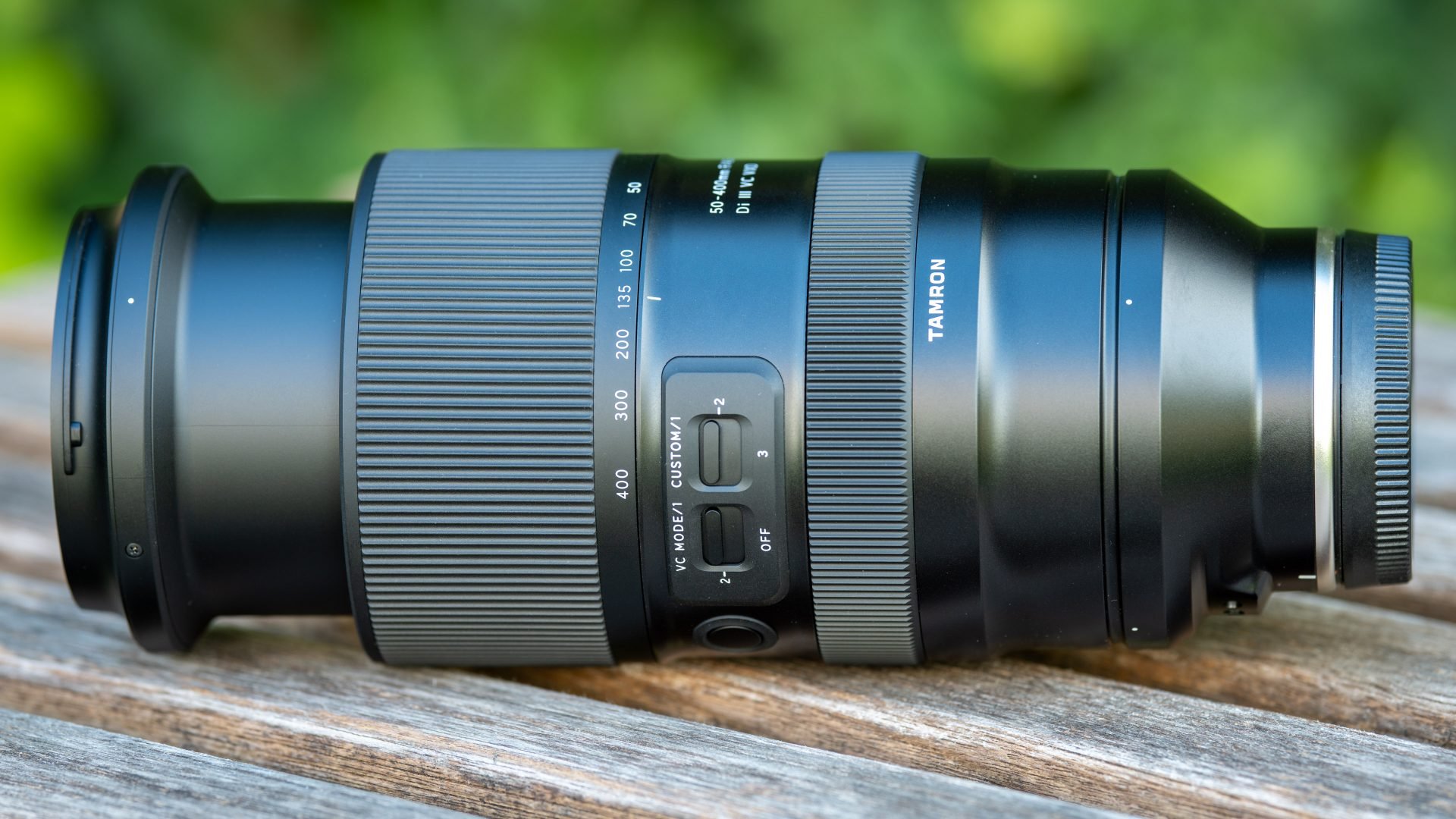
 Tamron's 50-400mm f4.5-6.3 Di III VC is a worthy addition to Tamron's extensive line of tele-photo zoom lenses. Despite its huge 8x zoom-range the lens is still relatively small and light and produces very sharp images even wide open up to 300mm focal length. The optical image stabilization of 3 stops could be more effective but is still helpful when shooting hand-held beyond 100mm focal length. The lens also offers good close-up capabilities. It may not have the brightest focal ratio but its versatility and image quality makes the 50-400mm f4.5-6.3 Di III VC certainly a very attractive option for those seeking to cover their tele-photo needs with a single zoom lens: Well worth the money and Highly Recommended.
Tamron's 50-400mm f4.5-6.3 Di III VC is a worthy addition to Tamron's extensive line of tele-photo zoom lenses. Despite its huge 8x zoom-range the lens is still relatively small and light and produces very sharp images even wide open up to 300mm focal length. The optical image stabilization of 3 stops could be more effective but is still helpful when shooting hand-held beyond 100mm focal length. The lens also offers good close-up capabilities. It may not have the brightest focal ratio but its versatility and image quality makes the 50-400mm f4.5-6.3 Di III VC certainly a very attractive option for those seeking to cover their tele-photo needs with a single zoom lens: Well worth the money and Highly Recommended.